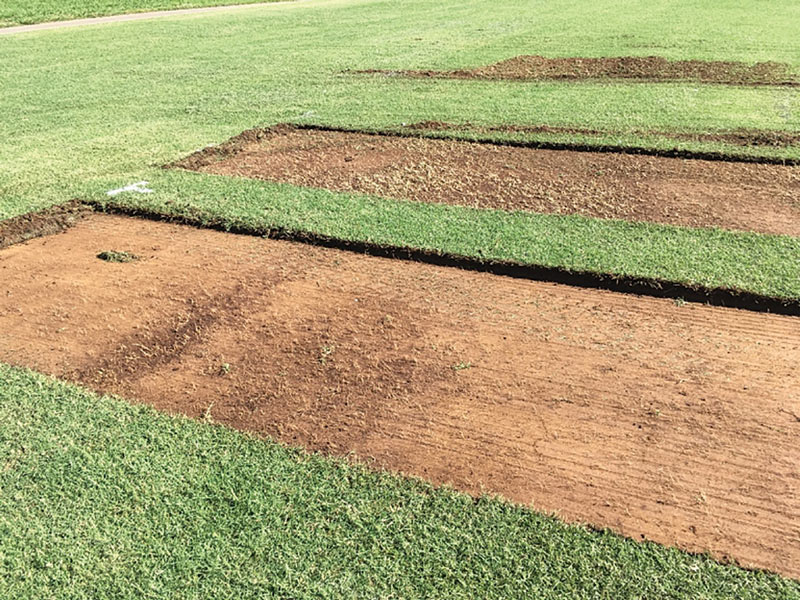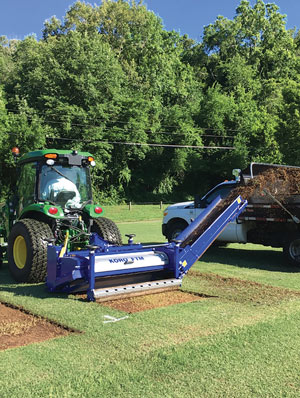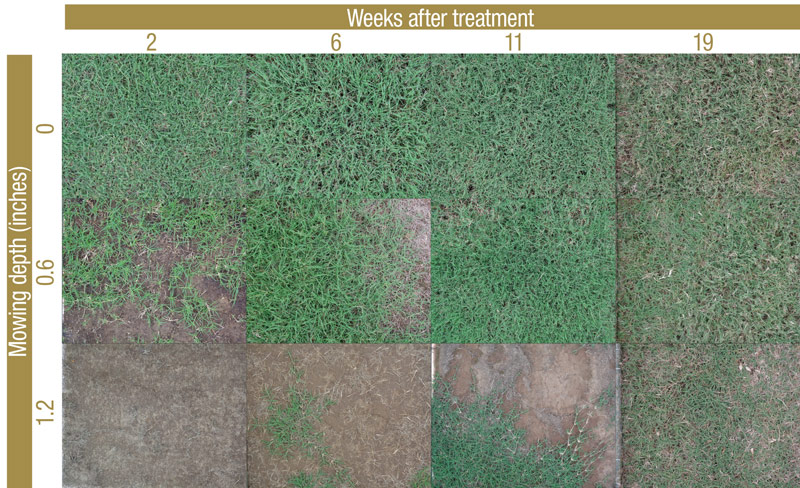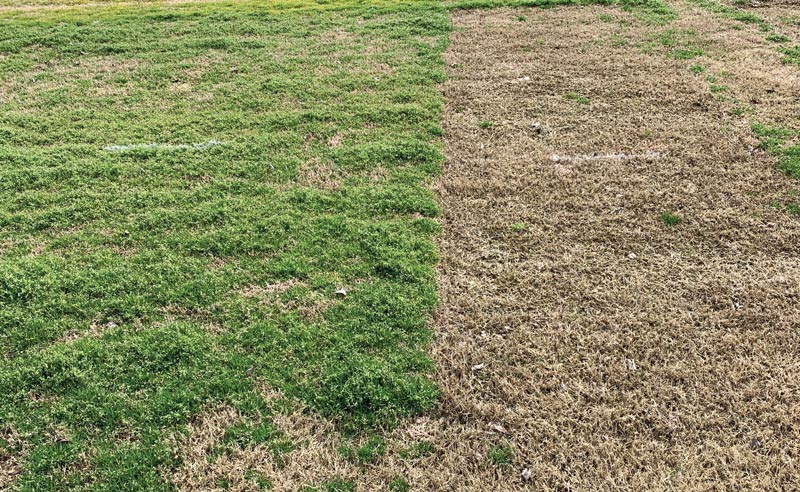
Figure 1. Experimental plots of Vamont bermudagrass (Cynodon dactylon) were fraise-mowed to depths of 1.2 and 0.6 inches and a control plot was not mowed during June 2019 in Knoxville, Tenn. Photos by Devon Carroll
Fraise mowing (also spelled “fraze”) is a new cultivation practice that physically removes large quantities of a turfgrass sward (that is, verdure, thatch, organic matter, soil) in a single pass (Figure 1). Fraise mowing can be used to renovate turfgrass surfaces, particularly athletic fields, or to reduce thatch and organic matter as a cultural practice (7). Fraise mowing is also a method for removing sand dams (also called collar dams) on golf course putting greens.
Given that weeds such as annual bluegrass (Poa annua L.) are known to produce high volumes of seed in the uppermost layers of the soil profile (2, 5, 9), fraise mowing may be a new tool for nonchemical weed management in bermudagrass (Cynodon species). Previous research on Meyer zoysiagrass (Zoysia japonica Steud.) and perennial ryegrass (Lolium perenne L.) reported 25% to 50% reductions in annual bluegrass coverage following a single fraise mowing event (1, 3).
Timing fraise mowing to facilitate turfgrass recovery is important from both a turfgrass quality and weed management standpoint. Fraise-mowed stands lacking density will result in lower turfgrass quality and be more susceptible to weed invasion. Researchers at North Carolina State University (6) assessed the regrowth of Tifway and Patriot hybrid bermudagrass (Cynodon dactylon (L.) Pers. × Cynodon transvaalensis Burtt-Davy) following fraise mowing at depths of 0.25, 0.50 and 0.75 inch (0.64, 1.27 and 1.90 centimeters) in May and June. At both timings, recovery was rapid: Fraise mowing in May required 28 days for full recovery, whereas only 14 days were required when fraise mowing was conducted in June.
Given the emerging epidemic of herbicide-resistant annual bluegrass populations in turfgrass, there is a need to explore new techniques for managing this problematic weed. Addressing the soil seed bank is a best management practice for controlling herbicide-resistant weeds in row crop production (8) and could potentially be employed in bermudagrass on golf courses via timely fraise mowing.
A national team of scientists from 15 universities received a grant from the U.S. Department of Agriculture-National Institute of Food and Agriculture Specialty Crop Research Initiative to help turfgrass managers address this epidemic of herbicide-resistant annual bluegrass on golf courses, athletic fields, sod farms and lawns (4). One objective of this research seeks to assess the efficacy of fraise mowing as a nonchemical technique to control annual bluegrass.
Editor’s note: Read much more about the USDA-NIFA research project — which aims to provide a clearer picture of Poa annua herbicide resistance, establish BMPs for Poa control, and deliver new support tools — in Poa annua: A plan of action.
The fraise mowing experiment
Researchers at the University of Tennessee and the University of Florida are conducting a two-year fraise-mowing study that started during summer 2019 in Knoxville, Tenn., and Jay, Fla. In Tennessee, the study site was composed of Vamont bermudagrass (Cynodon dactylon) maintained at a 1.25-inch (3.2-centimeter) height of cut. In Florida, the study site was a stand of TifSport hybrid bermudagrass that was more than 20 years old and maintained as a golf course fairway at 0.5-inch height of cut. Both sites have a known history of annual bluegrass infestation.
Fraise mowing treatments were the same for both locations and included depths of 0.6 and 1.2 inches (1.5 and 3 centimeters). A non-treated control (no fraise mowing) was included for comparison. Both studies were arranged as randomized complete block designs with four replications of plots (8 × 20 feet; 2.4 × 6 meters).

Right: Figure 2. One of the experimental treatments was fraise-mowing bermudagrass at a depth of 0.6 inch with a Koro Field Top Maker in Knoxville, Tenn., in June 2019.
Fraise-mowing treatments were applied in June 2019 using an Imants Koro Field Top Maker (KTM 1200, Aqua-Aid Solutions) affixed to the PTO assembly of a tractor (Figure 2). Immediately after fraise mowing, research sites were treated with oxadiazon at 3.0 pounds a.i./acre (3.36 kilograms/hectare) (Tennessee: Ronstar Flo at 122 fluid ounces/acre or 8.91 liters/hectare, Bayer Environmental Science; Florida: Ronstar G at 150 pounds/acre or 168 kilograms/hectare, Bayer Environmental Science) to prevent encroachment of summer annual weeds.
Bermudagrass recovery was quantified by assessing percent cover from two to 19 weeks after fraise mowing. On each date, bermudagrass cover in each plot was assessed visually and via digital image analysis. The impact of fraise mowing on annual bluegrass infestation was assessed monthly from January (32 weeks after treatment) to April 2020 (45 weeks after treatment). In Tennessee, a 10.8-square-foot (1-square-meter) grid with 100 intersections was used to quantify annual bluegrass infestations in each plot. Annual bluegrass was recorded as present or absent at each grid intersection. The number of intersections marked present was converted to a percentage and averaged within plots to determine annual bluegrass cover. In Florida, individual annual bluegrass plants were counted in a 5.4-square-foot (0.5-square-meter) area. Two grid counts were taken per plot on each rating date.
Fraise mowing effects on bermudagrass recovery
In Tennessee, bermudagrass recovered faster when it was fraise-mowed to 0.6 inch rather than 1.2 inches. Two weeks after treatment, bermudagrass cover was 30% in plots fraise-mowed to 0.6 inch compared with only 4% in plots fraise-mowed to 1.2 inches. Complete recovery (regardless of depth) was not apparent until 11 weeks after treatment (Figure 3, below). At 11 weeks after treatment, bermudagrass cover for plots fraise-mowed to a depth of 0.6 inch measured 97% (considered equal to cover of the non-treated control), and plots fraise-mowed to 1.2 inches had only 65% cover. By 19 weeks after treatment, plots fraise-mowed to 1.2 inches measured only 78% cover. Bermudagrass recovery in this study was not as swift as the two- to four-week recovery period reported previously for improved cultivars of hybrid bermudagrass (6).

Figure 3. Digital image analysis was used to evaluate the effects of no fraise mowing and fraise mowing to depths of 0.6 and 1.2 inches on Vamont bermudagrass (Cynodon dactylon) cover. Fraise mowing took place in June 2019 in Knoxville, Tenn.
In Florida, bermudagrass recovery occurred much more quickly than in Tennessee. At one week after treatment, bermudagrass cover was 28% in plots fraise-mowed at 0.6 inch, and 20% in plots fraise-mowed to 1.2 inches (Table 1). By three weeks after treatment, however, recovery was at 80% in the shallow fraise-mowed plots versus 29% in the plots fraise-mowed at the deeper depth. At five weeks after treatment, the plots fraise-mowed at 0.6 inch were not different from the non-treated plots, and the deeper fraise-mowed plots had recovered to 50%. Much like the plots in Tennessee, those in Florida took 11 weeks to recover completely.
Fraise mowing effects on annual bluegrass control
In both Tennessee and Florida, fraise mowing in June 2019 effectively controlled annual bluegrass by spring 2020 (Figure 4, below). Annual bluegrass cover in plots that were not fraise-mowed ranged from 33% to 62% (Tennessee) and 26% to 65% (Florida) during spring 2020. Comparatively, annual bluegrass cover in Tennessee ranged from <1% to 4% in plots subjected to summer fraise mowing — a response equal to a 94% to 97% reduction. In Florida, annual bluegrass cover ranged from 5% to 22%, equal to a 61% to 86% reduction. Additionally, there were no differences in annual bluegrass cover between plots subjected to the 0.6- and 1.2-inch fraise-mowing depths (Table 2).

Figure 4. The presence of annual bluegrass (Poa annua L.) infestation is obviously greater in Vamont bermudagrass (Cynodon dactylon) that was not fraise-mowed (left) than in the same turf fraise-mowed to a depth of 0.6 inch (right). This photo was taken March 18, 2020 (40 weeks after treatment).
Annual bluegrass control observed in bermudagrass in this study far exceeds that previously reported in zoysiagrass (24%) (3). Reasons for improved efficacy are not clear, but could be related to lower thatch production in bermudagrass, which allows fraise mowing to have a greater impact on the soil seed bank. Although fraise mowing in zoysiagrass was reported to reduce annual bluegrass, the researchers did not detect differences in the quantity of annual bluegrass seed in the soil of fraise-mowed and non-treated plots (3).
Editor’s note: Read more from this team of researchers about limiting annual bluegrass in the soil seed bank in When is Poa annua seed most germinable in spring?.
Take-home message
Although this experiment is ongoing, preliminary results suggest that fraise mowing can be an effective, non-herbicidal method of reducing annual bluegrass populations. This method may be of particular importance to golf course superintendents managing herbicide-resistant annual bluegrass or seeking alternative management strategies. However, implementing fraise mowing as a cultural practice on a golf course comes with challenges.
Golf course superintendents should consider the significant amount of debris created by fraise mowing in areas of large acreage. For example, debris analysis in a study of fraise mowing of zoysiagrass (3) showed that the volume of debris harvested from 1 acre (0.4 hectare) fraise-mowed to a 1-inch (2.5-centimeter) depth was approximately 20,700 cubic feet (586 cubic meters, or about one-fourth of an Olympic-sized swimming pool) of debris, weighing approximately 10 tons (9,071.85 kilograms). Additionally, fraise mowing may not be suited for areas of a golf course with significant undulation, because the process tends to make surfaces planar.
Superintendents may also find it difficult to implement fraise mowing considering that several weeks are needed for recovery, and periods of low turfgrass cover will likely be undesirable for golfers. Given that there was no difference in annual bluegrass control between the 0.6- and 1.2-inch fraise-mowing depths evaluated in this study, summer fraise mowing of bermudagrass at 0.6 inch would be advisable to hasten recovery time and reduce the volume of debris generated.
Funding
Funding for this research is provided by the U.S. Department of Agriculture Specialty Crop Research Initiative, USDA-NIFA-SCRI Award No. 2018-51181-28436.
The research says ...
- Increasing resistance of annual bluegrass to herbicides requires new methods of control that are nonchemical and effective.
- Preliminary work in Florida and Tennessee with fraise mowing showed significant reductions in annual bluegrass.
- Fraise mowing may not be ideal for golf courses because of slow turf recovery and the large amount of debris generated.
- Fraise mowing at 0.6 inch (the lower experimental depth) is as effective as fraise mowing at 1.2 inch and results in less debris and a shorter recovery period for the turf.
Literature cited
- Baker, S.W., A.G. Owen and A.R. Woollacott. 2005. Physical and chemical control of Poa annua on professional football pitches. Journal of Turfgrass and Sports Surface Science 81:47-61.
- Branham, B.E., G.A. Hardebeck, J.W. Meyer and Z.J. Reicher. 2004. Turfgrass renovation using dazomet to control the Poa annua L. soil seed bank. HortScience 39(7):1763-1767 (https://doi.org/10.21273/HORTSCI.39.7.1763).
- Brosnan, J.T., G.K. Breeden, J.M. Zobel, A.J. Patton and Q.D. Law. 2020. Nonchemical annual bluegrass (Poa annua) management in zoysiagrass via fraise mowing. Weed Technology (https://doi.org/10.1017/wet.2019.136).
- Grubbs, B., J. McCurdy and M. Bagavathiannan. 2019. Poa annua: A plan of action. Golf Course Management 87(10):70-75.
- Lush, W.M. 1988. Biology of Poa annua in a temperate zone golf putting green (Agrostis stolonifera/Poa annua). II. The seed bank. Journal of Applied Ecology 25(3):989-997 (https://doi.org/10.2307/2403760).
- McCauley, R.K., G.D. Pinnix and G.L. Miller. 2019. Fraise mowing as a spring transition aid. Crop, Forage & Turfgrass Management 5:190025 (https://doi.org/10.2134/cftm2019.04.0025).
- Minnick, J., and A. Reed. 2013. Concept to active practice: Fraze mowing bermudagrass makes debut. Sports Turf 29:26-29.
- Norsworthy, J.K., S.M. Ward, D.R. Shaw, R.S. Llewellyn, R.L. Nichols, T.M. Webster, K.W. Bradley, G. Frisvold, S.B. Powles, N.R. Burgos, W.W. Witt and M. Barrett. 2012. Reducing the risks of herbicide resistance: Best management practices and recommendations. Weed Science 60 (special issue):31-62 (https://doi.org/10.1614/WS-D-11-00155.1).
- Watschke, T.L., F.W. Long and J.M. Duich. 1979. Control of Poa annua by suppression of seedheads with growth regulators. Weed Science 27(2):224-231 (https://doi.org/10.1017/S0043174500043873).
Devon Carroll is a doctoral student at the University of Tennessee-Knoxville. Jim Brosnan is a professor in the Plant Sciences Department at the University of Tennessee-Knoxville and director of the UT Weed Diagnostics Center. J. Bryan Unruh is a professor at the University of Florida and associate director of the West Florida Research and Education Center, Jay, Fla. Chase McKeithen is a biological scientist at the West Florida Research and Education Center, Jay, Fla. Pablo Boeri is a graduate research assistant at the University of Florida, Milton, Fla.